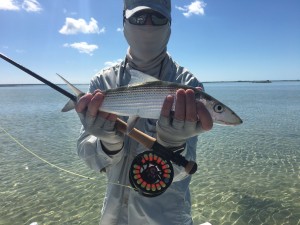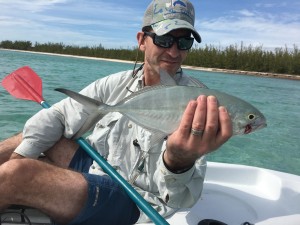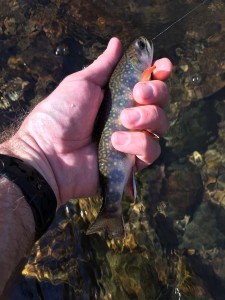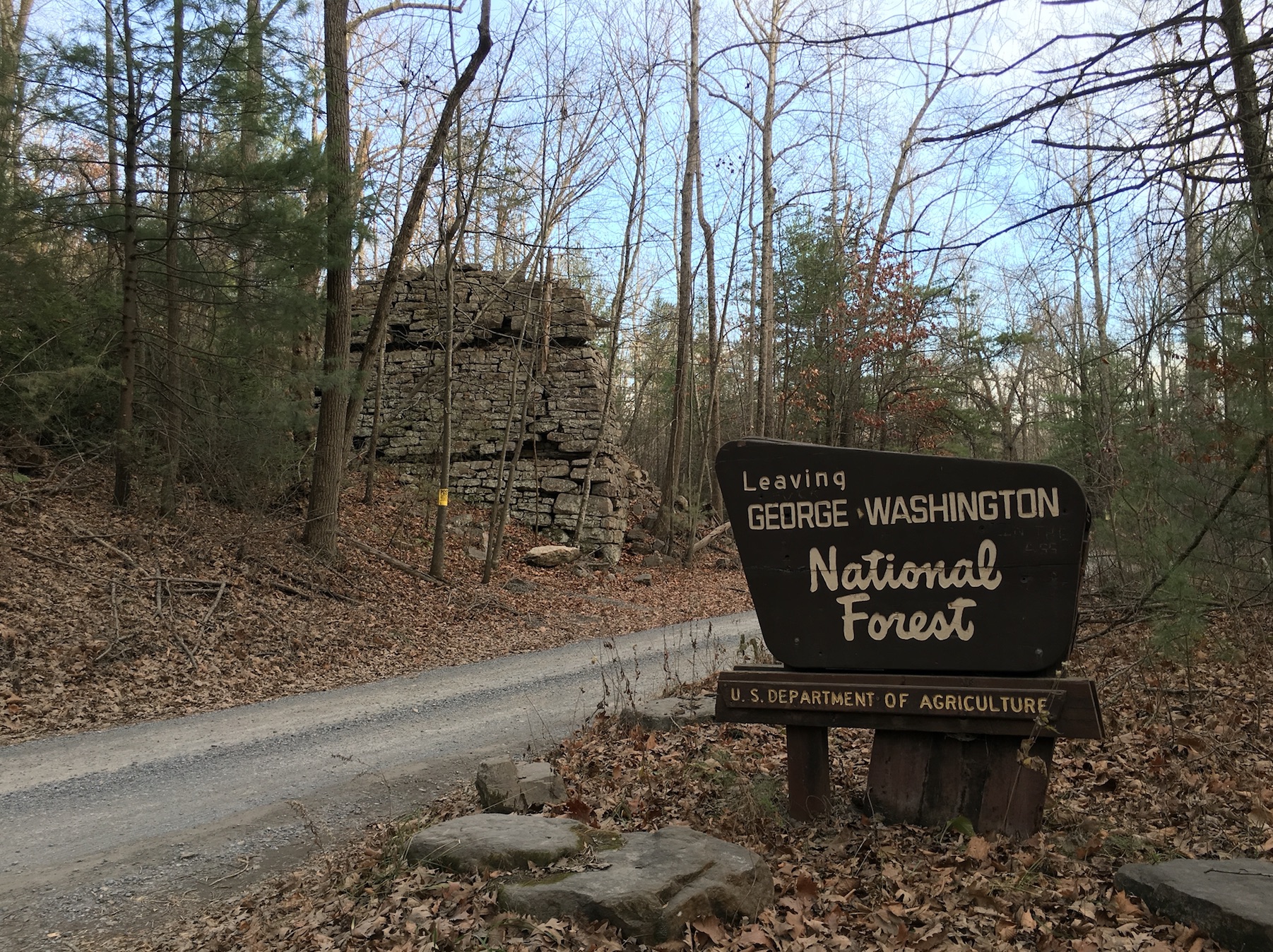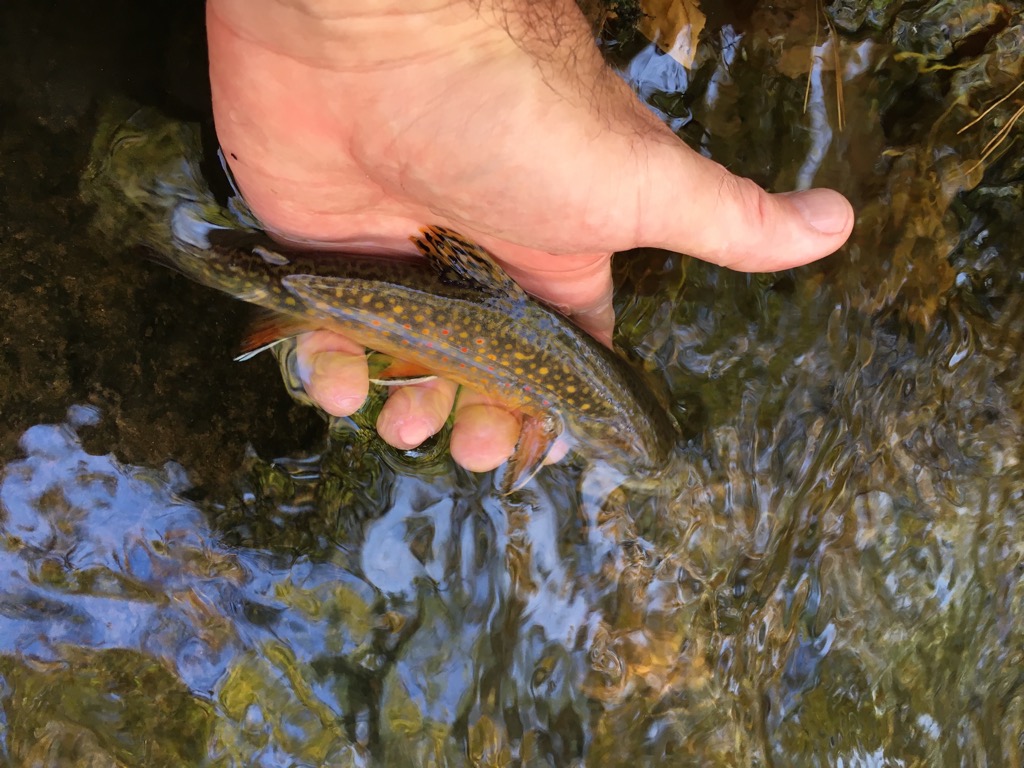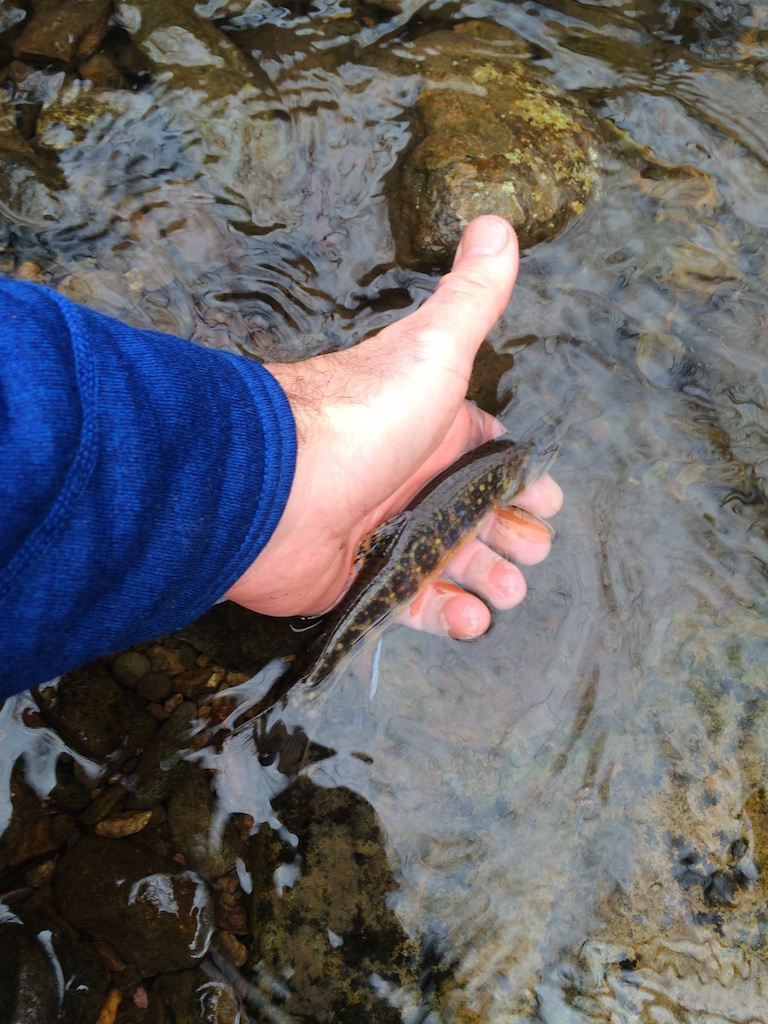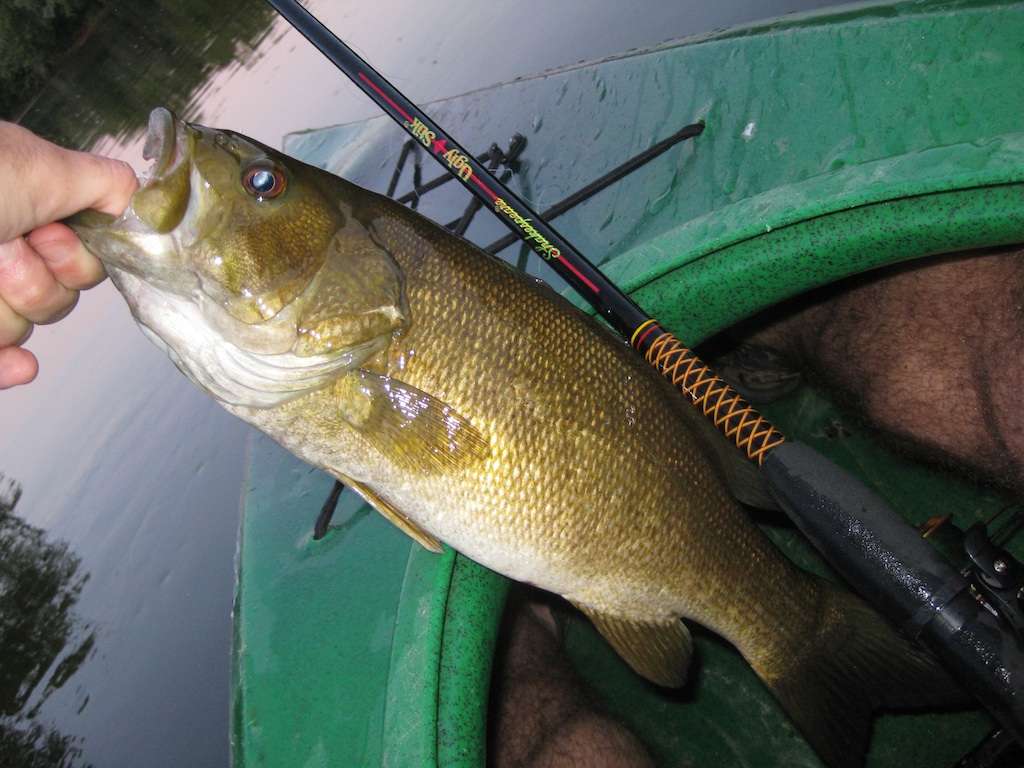Shenandoah
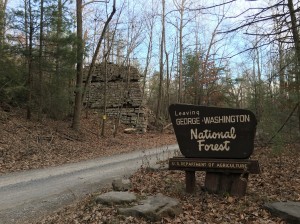 Fall and winter are great seasons to scout streams that may hold brook trout. In fact, it’s what I spent this past weekend doing. I explored two streams, one in the George Washington National Forest, and one in Shenandoah National Park. I had long suspected that each of these held brook trout but had never heard of anyone fishing either of them.
Fall and winter are great seasons to scout streams that may hold brook trout. In fact, it’s what I spent this past weekend doing. I explored two streams, one in the George Washington National Forest, and one in Shenandoah National Park. I had long suspected that each of these held brook trout but had never heard of anyone fishing either of them.
I left the fly rod in the car for each hike to the water. My goal was to sight at least one fish in each stream, to either confirm or possibly write-off any presence of brook trout.
The first stream runs along a dirt road in the national forest. It veers away from the road a short distance upstream from the only parking spot, and just downstream it is posted as private property. Normally, I would have hiked upstream along the public access to check it out, but it’s hunting season now and hunters were at turnouts all along the forest service road. I had left my blaze orange hat at home and was dressed in tans and other colors a little too deer-like, so I stayed put at the pool next to my truck. Luckily, after staring at the water for quite a while, I saw a lone brook trout, about eight inches long. It darted and weaved upstream in a flash and buried itself under a shelf of rocks. Success!
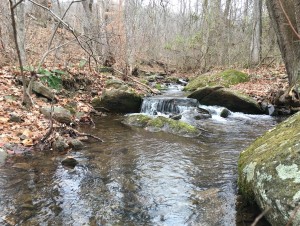 The second stream is one of the
The second stream is one of the forty-six ninety or so in Shenandoah National Park (depending on how you count them) that have populations of brook trout. I wasn’t able to find much info about this particular stream, so I drove down there and made an afternoon hike out of it. This is not one of the larger streams, but it has always looked promising. Most of the good-looking trout water seems to be quite a ways downstream. It wasn’t until a few hundred yards from one of the gates at the lower park boundary that I saw fish bolting at the sight of me in a few different pools. Again… success. Have to return with the rod to check out some promising spots further upstream.
I was hoping to see some fish guarding their spawning beds, but I saw none. A few years ago my wife and I had hiked down the trail along Jeremy’s Run the day after Thanksgiving. We saw brook trout guarding redds in one pool. I was hoping it was not too late, but Thanksgiving had been almost a week earlier than it was this year. They are probably done now.
By the way, interesting bit from the East Coast Fly Guy about fishing for brook trout during the fall. Last year, he emailed a few fisheries biologists and fly shop owners. Opinions will differ, but the biologists did not feel that there would be much impact on brook trout populations from fishing or wading during these times of year. I still think being a little careful when wading is a good idea, but it sounds like brook trout populations are resilient and much more affected by stream flows and persistent trends in weather.
When exactly do brook trout spawn around here? While there is no alarm that rings and signals it is time, it does begin in the fall. Depending on where you get your information, in Virginia, that time may be here.
Mossy Creek Outfitters reports on October 21, 2015:
Many brook trout are paired up or have already spawned. This is a controversial topic and we respect informed anglers decisions to fish or give the brook trout a break. Our shop does not guide on brook trout water during this season nor do we actively fish mountain wild waters now through winter. We understand many responsible anglers enjoy this time of year in the mountains. We ask that anyone fishing please do your best to stay out of the creeks as much as possible to avoid stepping on redds or possibly coating fragile eggs with silt stirred up from wading. Return fish quickly to the stream and observe the pools for actively spawning fish and redds. Remember that brook trout eggs will incubate on the streambed for 45-140 days depending on water temps! This means you will need to be careful in these creeks until early March most years! Enjoy the colors in the mountains and the great fishing but please be cautious. We want to ensure a great spawn this season.
Murray’s Fly Shop two days earlier:
The brook trout are spawning now and most anglers believe it is best not to stress them by fishing for them even though we return them to the stream.
The Shenandoah National Park website:
Brook trout spawn in the fall, most typically from early October to mid November within park streams. Spawning is triggered by decreasing day length and water temperature. Shallow depressions know as redds are excavated by female brook trout on typically gravel substrates. Redds are initially defended by both sexes followed by abandonment upon the completion of spawning. Hatching typically commences during mid to late January within park streams and juvenile fish begin to vacate redds by mid March.
I was on the Rapidan last week and I did not see signs of fish spawning there yet. However, that was at lower elevation and in roughly the middle of the park. Farther north and higher up on the Blue Ridge, spawning is likely to be underway.
It’s good to be aware of all this, and if you do fish, try not to step in the stream when you don’t have to. And don’t be greedy. It is easy to spot brookies when they are sitting still in the current guarding their redds. Brook trout are under pressure in a ton of ways. Choosing to avoid fishing for them while they are spawning is a personal choice, but spawning is a critical time for them to successfully reproduce, so please go easy if you are out there.
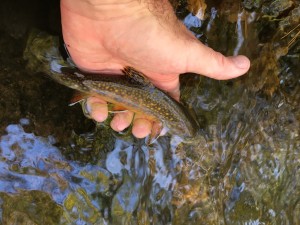
Great fall day! I went out yesterday intending to hit just the Rapidan River near and also within Shenandoah National Park. I turned this into a three-stream trip on a whim. Hitting three streams in one day is not my usual approach. The typical thing for me is to park on Skyline Drive, hike down below fishable water, fish upstream for a while, then hike back out. Always a workout. Today, it was all drive-by fishing.
The first detour was to one of the places I can catch decent brookies without hiking more than five minutes. Sure enough, I got the guy at the top of this post on a small Stimulator. That was good enough. I turned around and got back in the car, bound for the Rapidan.
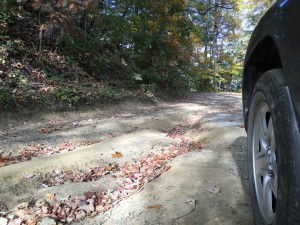
I haven’t fished the Rapidan in at least five years. It’s an odd place in the park, maybe the only stream where you can just about drive right up to all the good water and fish. Although “driving right up to the good water” makes it sound easy, see the photo — that’s a relatively mild section of the road. The road appears to be in much worse shape than when I was there years ago. And I suppose that’s a good thing. It probably keeps the fishing pressure a little lower than it would be otherwise. Despite the driving challenge, I did see a handful of cars and fishermen there. Maybe the VDGIF should drop a couple bombs and make it a little tougher still.
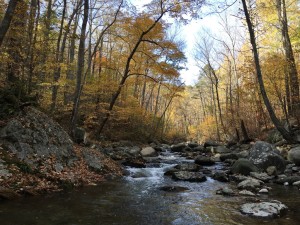
The fall colors are just past peak in the elevations, and there is lots of green in the valley. Overall, right now is probably peak color in the park. I suggest you avoid Skyline Drive this time of year. It is always crowded with gawkers and slow drivers in autumn.
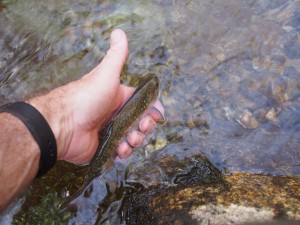
Fishing on the Rapidan was tougher than it should have been, all due to my fly selections. I tried Stimulators, Royal Wulffs, Mr. Rapidans, each with some success but lots of splashy refusals. What ended up really working, though, was a plain black foam beetle with a small orange square on top. I got the biggest fish on the Rapidan in a super shallow spot, at a moment when I was not expecting it. No photo of that one, sorry. Gotta remember (and I know this but am stubborn) — fall is a great time for terrestrials on brook trout streams.
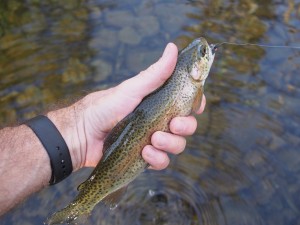
Heading out, I decided to fish the public stretch of the Rose River. I’ve always passed this by. Rose River Farm is right up the road and I have fished there twice. I was hoping that jumping in on the public section downstream of there would put me in contact with some of those big RRF trout that may have washed downstream. Well, that didn’t work out but I did get this one nice little rainbow.
Total stats for the day:
- Three streams — ten minutes on the first, and hour and a half on the Rapidan, and hour on the Rose
- Very little hiking, unusual in SNP
- About a dozen brook trout, and more refusals than I care to admit until I tied on the beetle
- One rainbow trout
- One Rosyside Dace
- Three fallfish, one pushing ten inches
- Three bluegill
- First leak in my waders
Yes, finally got a small leak in my cheapo LL Bean Emerger waders. Took a few years. Even though I try to be gentle on clothes, boots, and gear, these waders have seen more than their share of sliding down rocks, ripping through brambles, and other forms of assault. I’d give them high marks, especially considering the low price. Should be an easy patch job.
Anyway, beautiful fall brook trout fishing is going to wind down in the next couple weeks. Get out and enjoy the colors and the warm weather!
Data
Weather conditions: mostly sunny, winds SSW one to 7 mph
Air temp: 77
Water temp: unknown
Insect activity: none observed
Flies used: Stimulator, Royal Wulff, Mr. Rapidan
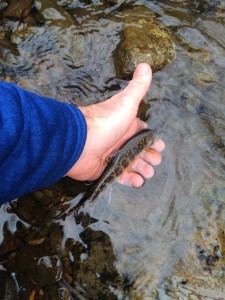 Looking back now, back over the long winter, past the worst of the weather, past the longing for warmer climes, past the bazillion flies I tied, past the trip to the Bahamas and the ten pound grouper I landed and the single bonefish I hooked and lost on our unguided not-a-fishing-trip trip… Past all that to a day on a small stream in Shenandoah National Park in early February. The forecast said temps of forty-something, which was a warm-up but still a cold and stone gray day. Snow was on the ground. The hike down from Skyline Drive was a slog. The water was cold, dry flies didn’t work, and so I did something I had never done before in the park, something that made this trip a first for me. I turned to the dark side.
Looking back now, back over the long winter, past the worst of the weather, past the longing for warmer climes, past the bazillion flies I tied, past the trip to the Bahamas and the ten pound grouper I landed and the single bonefish I hooked and lost on our unguided not-a-fishing-trip trip… Past all that to a day on a small stream in Shenandoah National Park in early February. The forecast said temps of forty-something, which was a warm-up but still a cold and stone gray day. Snow was on the ground. The hike down from Skyline Drive was a slog. The water was cold, dry flies didn’t work, and so I did something I had never done before in the park, something that made this trip a first for me. I turned to the dark side.
I tied on a freaking nymph. And damn if that nymph didn’t work like magic.
I’ve nymphed before, and it’s worked before, but I’ve never tried nymphing for brook trout in SNP. I did catch a brook trout on a nymph once. It was on a stream in one of the state game lands in Pennsylvania two and a half years ago, and the nymph was the venerable pink weenie. I had parked right next to the stream and walked to the water about thirty feet from the car. Pitched a short cast upstream on a tight line held high, drifted it through the likeliest seam right next to my feet, and repeated this unsavory practice two more times. That third cast got me the biggest brook trout I had ever caught to that point. It was a beautiful twelve inch male. I could almost hear his disdain as he wriggled and tried to spit the tungsten-headed, pink chenille abomination with the name I can never quite bring myself to utter to certain family members. The shame welled up inside of me. A nymph. The pink weenie. Both fish and I thought it was in poor taste, and borderline cheating.
Still, I was so happy.
But that was it. Literally EVERY other time I’ve fished for brook trout, it was, is, and — damn it — will be with dry flies! So if nymphs dredge up some nice fish pretty regularly, why do I shun nymphing? Well, because dry fly fishing is the best thing ever. And because nymphing, frankly, kinda sucks.
So maybe I’ve become unprincipled. This was now the second time I’ve nymphed for brook trout, and only because I was desperate. An hour drive and an hour hike each way, and when you’re standing on the edge of a stream in that beautiful park and nothing’s working, you do things you’re not proud to do.
The fish were in deeper pools mostly. I had stalked up to these spots and figured stealth was still in order despite the depths at which many seemed to be holding. In many pools, the fish were acting very territorially. In fact, it was that aggressiveness that made this whole shameful business of nymphing work great. I saw at least fifteen trout holding near the bottom of one pool, and my first cast drifted the bead head, rubber leg monster right to one of them. He snatched it without hesitation. The cool thing about it was that it was pure sight fishing. I guided the fly right to their noses when the current allowed. Others came from a few feet away to follow and ultimately eat it. Several of these brookies I caught more than once, and it was at that point that I realized this was getting unsportsmanlike and I moved on upstream to the next spot I could find, nymph still fully secured to the tippet. It went like that all afternoon.
Well, it’s springtime now. Thank God this nymphing stuff is over for a while.
The Pennsylvania Fish and Boat Commission is having a disagreement with the state Department of Environmental Protection about the condition of the Susquehanna River. The PFBC says the river is in trouble and should be listed as “impaired,” which will put the river on a “pollution diet” and begin to address the problems. The DEP says there is no proof that the river’s problems are caused by any specific environmental issues. If you read the second link above, it sounds like the DEP may be waiting on more data from USGS and others before it moves on this issue.
We’ve had similar issues in the past seven years or so on the Shenandoah, James, Potomac and other large rivers in Virginia and Maryland. These issues with fish kills, lesions and intersex bass all seem to be caused by a bad combination of environmental factors. So when the DEP says they have no evidence to zero in on specific causes, they are probably correct — technically. And this, of course, misses the whole point.
If you live in Pennsylvania and are concerned about the health of the Susquehanna, read the articles above and contact your representatives.
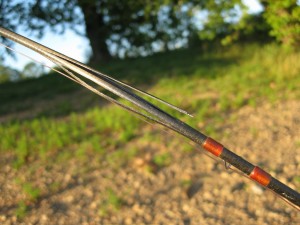
An unfortunate series of events on the Shenandoah River near home yesterday evening for sure. I was in a rush — that’s really all I need to say since you know where that always leads. Straight to disaster, though minor in the wide angle view of life, but still…
Beautiful day after the cold front came through. The humidity left, the clouds withered, and being the front end of summer I had about three hours of daylight left after I got home. So in my reckless haste I began to make a series of mistakes as I aimed to get down to the water and maximize my time there. It’s hard to say if any of the small missteps mattered (forgot the nice camera, the anchor for the kayak, the right hat, the good beer), though maybe they all led to the big one. That most painful error started with me deciding, uncharacteristically, to string up the fly rod in my driveway and then… wait for it… shove it in the car sticking out the window. Yeah, I know. The good thing was that nothing bad happened driving down our narrow dirt road to the river. The bad thing was that after parking the car, it was time to disembark and do the car parking ritual — car in gear, brake on, close up the sunroof and (ooops) CLOSE THE WINDOWS.
That fly rod had become one of my favorites, a nice find on eBay early last year, a Scott G, 9’6″ 8 weight two piece, about twenty years old. Still, it looked fine on my rush (that word again) inspection. So into the kayak it and I went, with a yellow size 6 popper on the end of that swank Orvis saltwater line and several bits of leader and tippet. First cast, a strike. The wind was blowing upstream so that was nice to not only cast in that direction but to have the wind push me that way, so no padding required to pretty much stay put in one spot. Anchor not needed. Everything was going my way. Second cast, nothing. Third cast — CRACK.
A noise I’m not familiar with.
I examined the rod, starting from the handle. Guide by guide on the way up, everything looks good, until the last quarter when I see the rod is splintered longitudinally into three shards of once expensive, now junk carbon fiber graphite tech material. Crap.
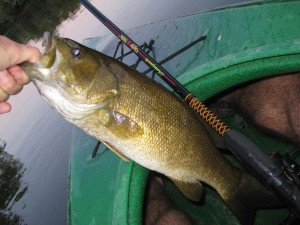
Back to the car and rig up the beefy Ugly Stick. Paddled to the deep holes near the big sycamores and cast right up against the weeds on shore, chugging and gurgling, pulling another popper (much bigger than the fly rod version) under the water and letting it float to the top like something wounded and dying. Cast-cast-cast-cast-cast about a hundred times and BAM! I hauled in the biggest smallmouth to date (for me) on the Shenandoah. Awesome!!! He jumped five times, dove several times, pulled me around a little, came up and was, as they always seem to be, royally pissed. Single hook right in the corner of the mouth. Photos all around then release. That was good.
Maybe not worth the broken rod, maybe worth it. No looking back now. Except at that fish.
A drag free drift is almost always necessary to entice trout. Almost always — see Murray’s Fly Shop’s latest tip for brook trout fishing and nailing those trout hanging in the tails of pools.
 See when the campgrounds, visitor centers and other facilities are opening this year at Shenandoah National Park.
See when the campgrounds, visitor centers and other facilities are opening this year at Shenandoah National Park.
Note also that there will be some prescribed burns near Big Meadows and at the park headquarters on Rt. 211. This could affect things for you if you’re fishing places such as the upper Hughes River, upper Hazel River, the South Fork of Dry Run, Pass Run, Jeremy’s Run and possibly other places, all depending on the weather conditions. No word on when these burns will occur. Check www.nps.gov/shen or call (540) 999-3500 for more details.
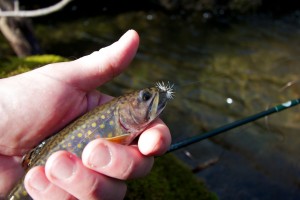
Just a quick update…
I got out this weekend to one of my favorite streams in Shenandoah National Park. Since it was in the mid-fifties and has been for days, it seemed like it would be worth a shot to once again and per my standard practice SHUN NYMPHING and throw some dry flies, see how I’d do, then pick up some barbeque at Mr. B’s afterwards.
A trip like this involves quite a bit of traveling for the amount of fishing. I don’t live too far from the park but it was still nearly an hour drive each way for this stream. Part of that is due to the 35 mph speed limit on Skyline Drive and getting stuck behind weekenders there who dutifully obey it. Once I parked it was another 45 minute hike downhill and about an hour hike back out. So right off the bat, that’s nearly four hours out of the day just to travel to and from the water. I managed to fish it for about two hours. I could have stayed longer but had to get back home for some reason that seemed important then but I really can’t justify or even remember looking back now.
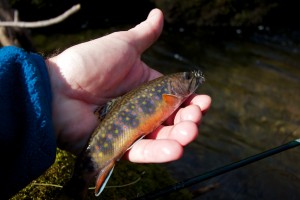 The fishing was awesome! Throwing dry flies and catching trout on the surface in the middle of winter is so much fun. I took a tip from my trip to Florida for redfish last month about sight fishing and decided to really try locating trout before just blindly casting to the seams and other good spots, like I typically do on small streams. I was pretty successful and managed to see many of the fish I caught before I even made the cast. This is a skill I’m going to try to make more of a habit, just slowing down a bit more and really trying to spot anything I can before making even that first cast.
The fishing was awesome! Throwing dry flies and catching trout on the surface in the middle of winter is so much fun. I took a tip from my trip to Florida for redfish last month about sight fishing and decided to really try locating trout before just blindly casting to the seams and other good spots, like I typically do on small streams. I was pretty successful and managed to see many of the fish I caught before I even made the cast. This is a skill I’m going to try to make more of a habit, just slowing down a bit more and really trying to spot anything I can before making even that first cast.
So I fished two flies, both of which I tied in the past week. The first was a size 12 Adams “Wulff” I think I’ll call it. I am not a huge fan of tying feathers for wings on dry flies. It just seems like it’s not always necessary. I simply used some synthetic white yarn instead to make a split wing and wrapped it in a ton of brown and grizzly hackle. Seemed to float fine, cast well and fooled fish. Not sure I’ll go back to feathers for Adams style flies any time soon.
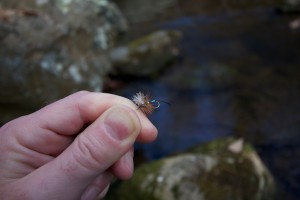
The second fly was a size 12 Patriot. This is the first season I’ve tied this pattern, and it was based on a tip from Paul Kearney who runs the Trout Unlimited fish camp for kids, and who has fished the park for over forty years. I also just got Charles Meck‘s book, Mid-Atlantic Trout Streams and Their Hatches. Charles Meck is the creator of the Patriot dry fly. Typical for a brook trout stream, it worked just fine, too!
After I caught a fish or two and the fly became soaked, I put aside my principles and drifted it under the surface. Yes, nymphing! I watched several fish rise off the bottom and slurp the waterlogged fly. The first few were with an Adams, the second batch with the soaked and slimed Patriot.
A note about wading in winter: I severely limited my wading in the stream on this trip, really just wading on the very edges of the water or on shelves of big rocks and boulders. I avoided walking on the gravel and free stone areas as completely as I could. The brook trout have just finished spawning and trampling through the streams, while never a good idea, is much worse of an idea at this time of year. If you do go be very careful. There are a lot of very small fish on the bottom and we don’t want to smush our future brook trout brood.
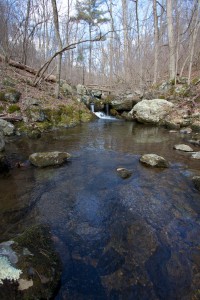
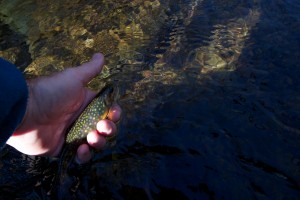
My quest to catch at least one fish every month this year has begun. Preferably I’d like to catch a dozen fish each month. So far, I’m on track!
Yes!
